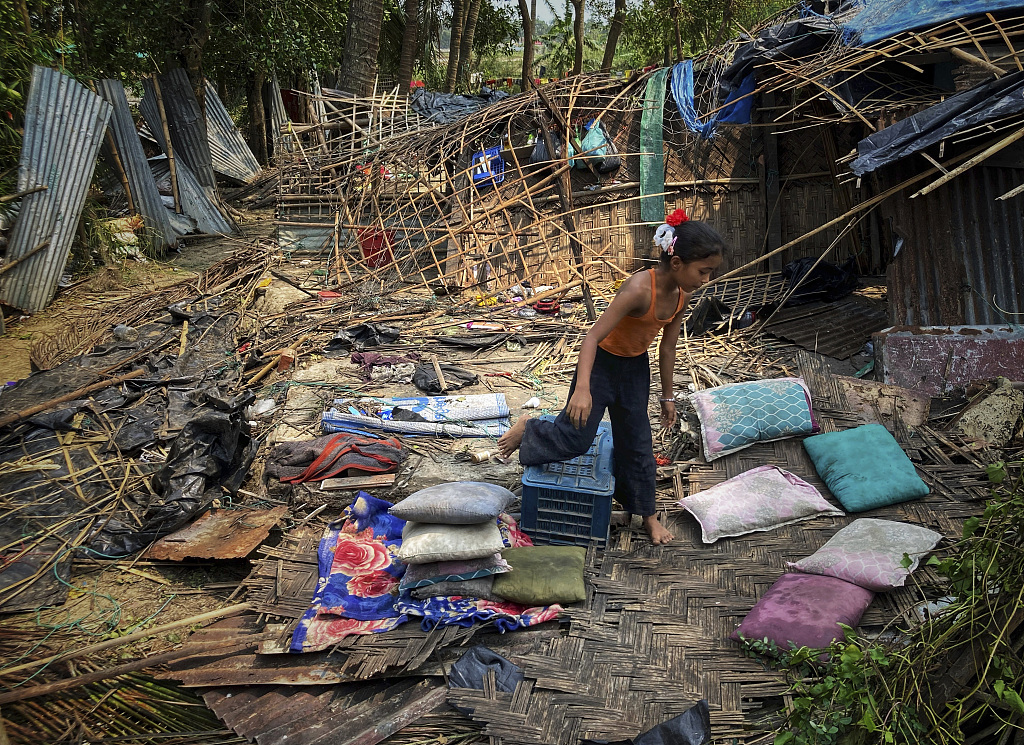The 19th World Meteorological Congress (Cg-19) has set the implementation of the "Early Warnings For All" initiative by 2027 as the top priority in the World Meteorological Organization's (WMO) Strategic Plan 2024-2027.
After the two-week Cg-19, which closed on Friday in Geneva, the World Meteorological Congress, the top decision-making body of the 193-member WMO, wrote in its resolution that building life-saving early warning systems by the end of 2027 "has been officially recognized as the top overriding priority" of the WMO.
Key WMO activities should be coordinated and consolidated under the "Early Warnings for All" umbrella and WMO programs, technical commissions and regional activities aligned to achieve the goal, the resolution said.

A child runs through the wreckage of her home damaged by Cyclone Mocha at Saint Martin island in Cox's Bazar, Bangladesh, May 15, 2023. /CFP
A child runs through the wreckage of her home damaged by Cyclone Mocha at Saint Martin island in Cox's Bazar, Bangladesh, May 15, 2023. /CFP
Noting that multi-hazard early warning systems have saved countless lives, WMO Secretary-General Petteri Taalas said that only half of the countries have early warning systems in place, with coverage especially low in Small Island Developing States (SIDS), Least Developed Countries (LDCs) and Africa. "The death toll is disproportionately high in these countries," he added.
The months ahead will see stepped-up coordinated action in building the early warning systems, initially in 30 particularly at-risk countries, including SIDS and LDCs, the WMO said in a press release issued on Wednesday.
Besides, the Congress approved a new Global Greenhouse Gas Watch to strengthen the monitoring of heat-trapping gases and inform the implementation of the Paris Agreement on climate change.
In addition, it called for urgent and coordinated actions to tackle rapid changes in cryosphere and hydrology given the increasing impacts of diminishing sea ice, melting glaciers, ice sheets, permafrost and snow on sea level rise, water-related hazards, and water security.
"Extreme hydrometeorological hazards accounted for more than 90 percent of the world's disasters, which increased fivefold over the last 50 years," Taalas said.
While updating the WMO's science and innovation policy to adapt to new research priorities and embrace the technological might of supercomputing and artificial intelligence, the Congress also called for efforts to close the growing capacity gap, which threatens observations and services.
As Taalas ends his second four-year term in office at the end of 2023, the Congress appointed Celeste Saulo, director of the National Meteorological Service of Argentina and the WMO's outgoing first vice president, as his successor. She will take office as the WMO's first female secretary-general on January 1, 2024.
Abdulla Al Mandous, director general of the National Center of Meteorology in the United Arab Emirates (UAE), the UAE's permanent representative to the WMO and president of the WMO Regional Association for Asia, was elected president of the WMO, succeeding Gerhard Adrian of Germany. A new Executive Council was also elected.
(If you want to contribute and have specific expertise, please contact us at nature@cgtn.com.)
Source(s): Xinhua News Agency